History
De Liefde was originally called Erasmus and was later renamed De Liefde ('The Love'). She was the first Dutch ship to reach Japan, and thus the start of Dutch Japanese relations. She was part of a squad of four ships (Liefde, Hoop, Geloof and Trouw) and one yacht (Blijde Boodschap) rigged out by a predecessor of the Dutch East India Company called the Rotterdamsche Compagnie or Magelhaanse Compagnie (because they were trying to establish a trade route to Asia via the Strait of Magellan). When they were crossing this strait, a ship called Postillon was added to the squadron. This was a big sloop that had been transported in the hold of the Hoop in four pieces.
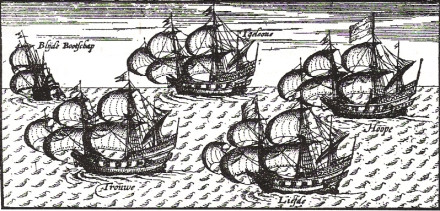
The fleet; from left to right the Blijde Boodschap, Trouw, Geloof, Liefde and Hoop. Engraving from a book called Wijdtloopigh Verhael, ca. 1600.
The fleet departed on June 27th 1598 and was led by admiral Jacques Mahu and vice-admiral Simon de Cordes. It was not a lucky expedition. Many crew members died of scurvy at the west coast of Africa, one of them admiral Mahu who died on September 23rd near the Cape Verde islands. Cordes, until then captain of the Liefde replaced him and Gerrit van Beuningen became the captain of that ship. The squadron did cross the Atlantic Ocean in January 1599 and wintered in the Strait of Magellan.
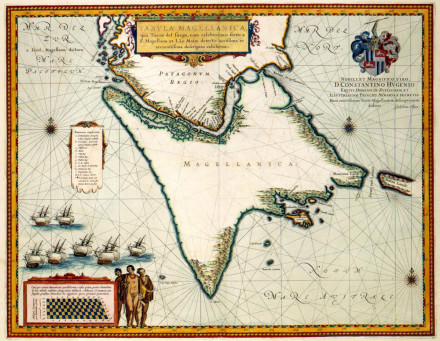
Getting through the Strait of Magellan took them another four months. It was not before the 3rd of September 1599 that they reached the Pacific. Here, heavy storms scattered the fleet and only the Liefde and the Hoop remained together. Another 120 men had died of the hardships during this winter.
Disaster in Chile
The Liefde and Hoop were separated from the rest of the fleet. They decided to wait at several rendez-vous points to refresh and wait for the rest of the fleet. On November 9th they reached Punto de Lavapie in Chile and landed to get supplies. They were attacked by the indigenous inhabitants who thought they were Spanish. Through lack of weapons they had to negotiate with these people. The next day they landed again to try and get in contact, but 23 crew members, including vice-admiral Van Beuningen were ambushed and killed. The disaster was complete and the Liefde set sail for the island of Santa Maria, which lay at a distance from the coast. The ship was barely capable of sailing, for only 30 crew members survived. At the other side of the island, to the joy of the men of the Liefde, they found the Hoop at anchor there. This ship had met with a similar fate as the Liefde. She lost 26 men including admiral Cordes, also killed attacks by indigenous people on the island of La Mocha.
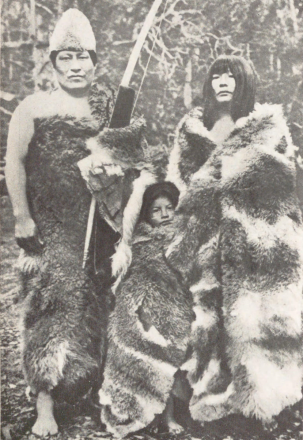
Destination Japan
Jacob Jansz. Quackernaeck became the new captain of the Liefde. With barely enough men to sail the two ships it was decided to sail to Japan. One of the reasons to choose Japan was that part of the cargo consisted of eleven chests of coarse woolen cloth. The men thought the climate in Japan was better for trading wool than in the more tropical East Indies. On the 27th of November, supplied and ready, they set sail across the Pacific. According to the letters of navigator William Adams, they lost sight of the Hoop near the Mariana islands on 24th February, and the ship was never seen again. On the 24th of March they reached Iwo Jima in Japanese waters. They reached Japan near Bungo (present-day Usuki) on the coast of Kyūshū in April 1600.
There, the surviving crew (24 crew members survived the voyage though a few died after arrival) was captured and the ship plundered. The survicvors were later released by the Japanese authorities. Civil war was waging in Japan at the time. The 18 Dutch cannons from the Liefde played a major role in the battle of Sekigahara (on 21 October 1600) between rivaling generals Ishida and Tokugawa. The battle was won by Tokogawa with help of the Dutch cannons that had been taken by his retainers. This battle marked the beginning of the Tokugawa shogunate, which lasted until 1868.
William Adams stayed in Japan, but ome of the Dutch survivors were given a junk by the Japanese which they used to sail to the Netherlands in 1605, with an invitation to establish a trading post in Japan.
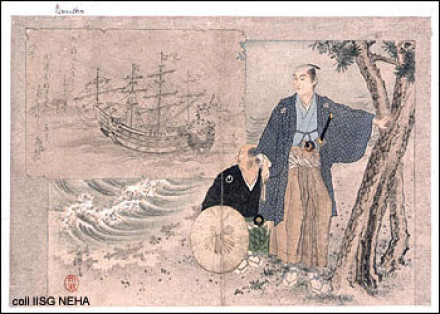
Dejima
Soon after the establishment of the Tokugawa shogunate, the Portuguese and the Jesuit monopoly of trading with Japan was broken. Trade was taken over by other European nations the such as English and the Dutch who first established trading posts in Hirado.
In the end, the Portuguese were expelled in 1639. From then on the only Europeans allowed in Japan were the Dutch. They had to settle on the small artificial island of Dejima in the Bay of Nagasaki. For over 200 years Dejima and a similar Chinese trading post were the only gateway between Japan and the rest of the world.
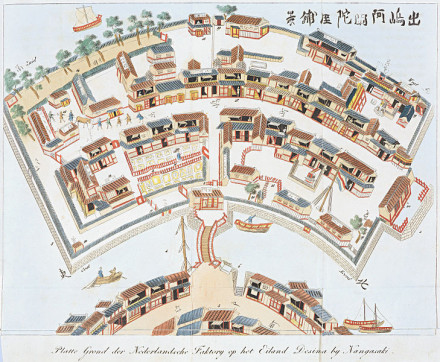
Navigator William Adams
The navigator of the Liefde, an Englishman named William Adams learned Japanese and became an important advisor to shōgun Tokuguwa Ieyasu. Until the arrival of the Liefde, the Portuguese and especially the Jesuit order were very influential in Japan. They were spreading Catholicism and monopolised the trade with the outside world. Ieyasu was very interested in these other Europeans, especially because he intensely disliked the spreading of the faith (and by this the gaining of political influence) by the Portuguese.
The Dutch merchant, called Jan Joosten van Lodensteyn, also remained in Japan and became an important factor in the trade relations between the two countries.
Grave of William Adams found
Archaeologist found the grave of William Adams in Hirado near Nagasaki in 2019. Adams's final resting place had been a mystery for more than four centuries but archaeologists in Nagasaki believed they had discovered his remains. The identification was made possible by painstaking forensic tests and research in both Japan and Britain.
Shots from the 1980 series.
The story of Adams model for James Clavell’s key character in his novel Shogun (1975), which has been made into a series twice, first in 1980 by Paramount and then in 2024 by Disney.
Description
Owner: Magelhaense Compagnie
Tonnage: 200 last
Armament: 18 guns
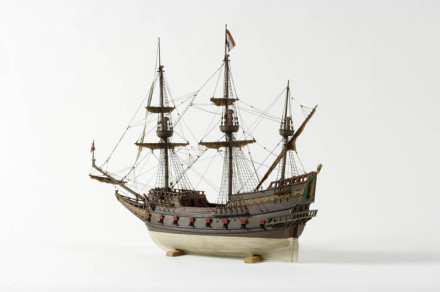
The entire fleet that left the Netherlands consisted of 5 ships:
Hoop, 130 men, admiral Jacques Mahu.
Geloof, 109 men, Gerrit van Beuningen.
Liefde, 110 men, vice admiral, Simon Cordes.
Trouw, 86 men, Jurriaan Bokhout.
Blijde Boodschap, 56 men, Sebald de Weert.
Of the 110 people on board, only a handful of names have survived. Two came from England
Simon de Cordes vice-admiraal van de vloot
Jacob Jansz. Quackernaeck, latere schipper
Dirck Gerritsz. Pomp, eerste Nederlander die in China en Japan was geweest ,
Fransoys Verjuys, boekhouder
Jan Joosten van Lodensteyn ,
Melchior van Santvoort, schrijver commies
Thomas Adams, jonger brother of
William Adams.
Jan Cousyns, Schieman
Diederick de Groot, schieman
Pieter Jansz, timmerman
Jan Abelsz.
Pieter Adriaansz. Blanckert, bootsgezel
Gisbert de Coninck
Jan Cornelisz.
Thomas Cornelisz.
Dammas Maertsz.
Michiel Psychz.
Jan Jacobsz. Roos
Jan Gerritsz. Tol
Jacob. ?
Albartusm
Jacob Swager
| Master | Simon Cordes |
|---|---|
| People on board | 110 |
Status
The ship was plundered upon arrival and put at anchor in a bay, where it was lost somewhere in 1600. The only part of the ship that remains is a statue of Erasmus. It is unclear where the ship was lost.

Originally the Liefde was called the Erasmus. On the stern it had a carving of the famous Rotterdam scholar Erasmus (1466-1536). Upon arrival in Japan, the ship was plundered and the statue was probably taken. For centuries, the Erasmus carving was kept in a temple. It was rediscovered in 1926, and now is on display in the Tokyo National Museum.
On the island of Kuroshima, at the place where the crew probably landed, a memorial has been established. It is on a small square at the end of the beach. A mosaic depicts the route that the Liefde traveled and the Dutch, English and Japanese flags are hoisted. At the monument, there are bronze busts of Jan Joosten van Lodensteyn and William Adams.
Besides this there is a replica of the carving of Erasmus. The monument was unveiled on April 19th 2000 by crown prince Willem-Alexander of the Netherlands in the presence of crown prince Naruhito. This was done to commemorate 400 years of relations between the Netherlands and Japan. The arrival of the Liefde is seen as the start of this. There is also a small museum on the island dedicated to the ship.
References
- De Liefde (galjoen).
- The Dutch in Japan.
- DAS 0021.1.
- Dutch-Asiatic Shipping.
Details of voyage 0021.1 from Goeree. - Barreveld, D.J. (2001).
De Route om de West deel 2, De liefdes tragiek en triomf (Deel; 2).
Niesje Wolters van Bemmel. - Atlas of Mutual Heritage.
Atlas of Mutual Heritage.